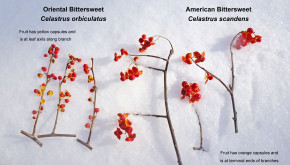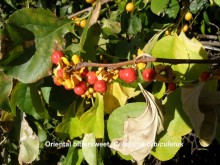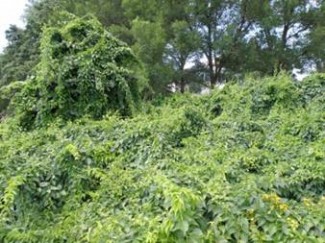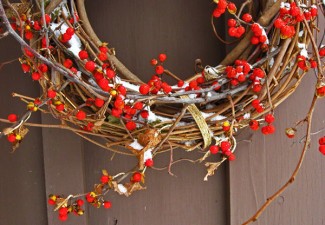
I originally wrote this article back in 2013, but as the holidays are annual and magazines with lovely fall and holiday decorations are now hitting the shelves I've decided to refresh it and add this great video. Further I'm offering a challenge: If you see Oriental bittersweet highlighted for use in a publication, write to the editors and explain why it's bad and help promote American bittersweet instead.
As you prepare for the winter holidays with festive decorations and good cheer be on the lookout for a quite but devastating forest killer: Oriental bittersweet. This attractive vine has been used in holiday decorations, and other crafting items, for years because of the beautiful fruiting branches which have red berries and yellow fruit capsules spread along the stem. However these same persistent berries that make wreaths delightfully charming easily spread seed of this terrible invasive. Fortunately, the eastern 2/3 of the US is home to the native vine American bittersweet that is superior with wonderfully persistent red berries with orange fruit capsules. On American bittersweet, the berries are clustered at the end of the stem, rather than spread out along the length of vine as in Oriental bittersweet. By keeping a watchful eye on your holiday decorations you can enjoy the attractive look and craftiness of American bittersweet decorations while feeling confident you are not spreading an invasive species.
A few key points to help identify Oriental (bad) bittersweet from American (good) bittersweet in crafts (for more information and pictures click here):
Seed capsules: Oriental bittersweet has yellow seed capsules on red berries (Give a yell when you see
yellow.) whereas American bittersweet has orange seed capsules on red berries (Orange is OK.)
Berry placement: Oriental bittersweet has berries strung-out along the stem (Strung-out is bad) while American bitterswee
t’s berries are all clustered near the end (Saving the best for last).
Bittersweet beyond decorations
Oriental bittersweet, Celasturs orbiculatus, is native to eastern Asia and was planted in North America for ornamental uses as early as 1736. The vines are easily propagated, grow vigorously in a wide range of environmental conditions and produce attractive fruit that has been used by the cut-flower and craft industries. American bittersweet, Celastrus scandens, is native to much of the temperate United States. American bittersweet vines are also vigorous but are much better behaved and produce larger and showier fruits. Both species are diecious, have separate male and female plants, and produce flowers but only female plants produce fruit. The species are easily distinguished by fruit (female plants) and flower placement (male and female plants) at the leaf axils of Oriental bittersweet versus only at the terminal ends of American bittersweet and fruit capsule color. Oriental bittersweet has yellow fruit capsules and American has bright orange capsules.
Oriental bittersweet has escaped cultivation and is strangling and smothering entire forest stands. It can dominate tree canopies and reduce forest floor light to levels that prevent other plant species from growing. The vine weight, compounded with snow and ice or high wind, can break trees. Heavy infestations result in swaths of downed trees covered with Oriental bittersweet vines and little else. Given damage levels, many states regulate Oriental bittersweet to prevent movement through the sale and distribution of this species. These states include Connecticut, Massachusetts, Minnesota, New Hampshire, North Carolina, Vermont and Wisconsin. Oriental bittersweet is considered a serious invasive plant management issue in many additional states.
Oriental bittersweet has been used by the floriculture industry. However, please use American instead of Oriental bittersweet. American bittersweet fruit is larger, showier and better retains the colorful fruit capsule. It is important to distinguish the species since stock is sometimes labeled as bittersweet without further description. When people use Oriental bittersweet fruiting branches to make seasonal arrangements, they inadvertently move seed to new locations. If arrangements such as wreaths are placed outside, birds can eat the fruit and move the seed to new locations. Composting spent arrangements has resulted in new infestations. Existing arrangements containing Oriental bittersweet should be bagged or burned for disposal.
Bittersweet in Minnesota's Woods
Bittersweet, both American and Oriental, have been used for many years as landscaping vines. It is possible you have one or both on your property. Winter is a great time of year to identify vines in the landscape. The berries will be visible and fairly showy when the summer foliage is down. You can look for red berries with orange seed capsules on light colored woody vines. Bittersweet vines do not have tendrils to hold onto trees, arbors or other supports, rather they encircle them for support. (They can look like a boa constrictor snake wrapping tightly around trees.) In large infestations Oriental bittersweet can be obvious because of the mass of scrabbled vines hanging throughout a wide swatch of tree canopies. Wild grape is most often confused with bittersweet. Grape has a large woody vine but it does not have persistent berries (you would recognize grapes!) the grape vine is a dark chocolate color with flaking/shaggy bark – something you could imagine Tarzan using to swing through the jungle. Both bittersweets by contrast have thick woody vines that are greyish (older vines) and light brown (younger vines) colored with a bark that does not peel and bumps are visible on young vines. Older bittersweet vine bark is sometimes confused with ash tree bark. There are three other common vines in our forests: Virginia creeper, woodbine (often confused with Virginia creeper) and poison ivy. These vines all have very recognizable leaves, but importantly for winter identification, they also all have tendrils on their vines. These vines use their tendrils to grab onto trees and other support structures. (Please note even the vines of poison ivy can cause a rash, so if you are unsure of a vine with tendrils it is best to leave it alone.) If you locate a suspicious vine on your property look for fruit, seed capsule color (orange = OK and yellow = yell for help) and fruit placement (Oriental bittersweet has berries along the length of the stems). It is possible to find male bittersweet without berries, in that case you will have to come back in the spring and look for flower placement.
Oriental bittersweet in Minnesota
A current map of Oriental bittersweet in the US, with zoom capability to individual points, can be found on the EDDMaps (Early Detection Distribution Maps for invasive species) website, or by clicking here. Oriental bittersweet has the potential to invade most, if not all, of the eastern US. Living up north may not protect you from this nasty vine. In addition, because Oriental bittersweet has been commonly used for crafting and wreaths it has been found near cemeteries, likely spread by the birds when decorative memorials containing Oriental bittersweet were left on site.
Birds and bittersweet
As mentioned above bittersweet can be carried by birds as they feed on the berries. Winona State University did a study and found Oriental bittersweet becoming established under blue bird boxes. So if you have bird feeders or bird boxes around your property please take an extra minute or two to notice if there is any Oriental bittersweet growing there. Birds are also excellent vectors of several other invasive species including buckthorn and honeysuckle. You may be amazed at what you find growing under those bird houses. Stopping these vines when they are small and contained is the easiest form of management.
Oriental bittersweet management
Without management, beautiful forests so important to recreation and tourism could be destroyed. Oriental bittersweet is designated a Minnesota Noxious Weed on the Eradicate List. Two important pieces in this law include: “These species must be eradicated, meaning all of the above and below ground parts of the plant must be destroyed” and “no transportation, propagation, or sale of these plants is allowed.” This means landowners need to destroy live plant material and avoid moving seeds. Thankfully the Minnesota Department of Agriculture, University of Minnesota and Conservation Corps Minnesota recently received some funding to eradicate this plant; hopefully we can prevent Oriental bittersweet from becoming the next buckthorn.
Oriental bittersweet management in the forest will likely involve either a foliar spray (spraying the leaves), cut stump (cutting the vine and treating the cut stump) or basal bark herbicide treatment (using an herbicide mixed with bark oil that will penetrate the bark). For large infestations please contact the MDA (information below) before proceeding with treatment. Small vines can be pulled and bagged or burned. It is important to note when pulling that these vines can root where they touch the ground, not just at the roots, so pulling them and tossing the vines on the ground will not kill them. The vines should either be treated with an herbicide or bagged or burned. NOTE: Burning live Oriental bittersweet in an effort to kill it, like in a prescribed burn for forest or prairie management, will not kill Oriental bittersweet, but will instead lead to a new flush of vigorous growth. For more information about Oriental bittersweet management in Minnesota view: Defeating a Killer Vine:
Engaging Guests in the Quest
Depending on your establishment and your guests’ activities hunting for invasive species like Oriental bittersweet, buckthorn, honeysuckle or garlic mustard (for more about these invasive species visit http://www.myminnesotawoods.umn.edu/) could be a fun activity like geo chasing. A small treasure hunt could be created on trails and paths to help guests appreciate the unique species of your facility while also being on the lookout for less desirable newcomers.
For locations with large invasive species infestations Ecotourism could be a way to engage guests in removal or management activities; allowing guests to feel empowered and making a difference for the environment.
Another important tool to limiting invasive species spread is to make sure everyone cleans their boots, clothing and gear before they start recreating on your property or going home. Much like a floor mat helps stop muddy boots from soiling a clean carpet, boot brushes near entrances, trail heads, or known infestations can make a big difference in preventing the spread of invasive species. Play Clean Go (http://www.playcleango.org/) is a new initiative lead by the Minnesota Department of Natural Resources to help remind everyone to enjoy themselves and play, then clean and head out. This message could resonate with your guests as well. This initiative was intentionally designed to be positive and empowering. We want everyone to enjoy living, working, playing and visiting Minnesota. But we also want to protect the very natural resources that make Minnesota so special!
To Report Oriental bittersweet in Minnesota
If you think you have found Oriental bittersweet please report this find so we can be sure it gets addressed. There are three easy ways to report a find:
· Call Arrest the Pest (you will be asked to leave a message): 1-888-545-6684
· Email a report (most valuable with a GPS or street location and a picture for ID): http://www.mda.state.mn.us/arrestthepest
· Or report online via an online reporting form: http://www.eddmaps.org/midwest/report/
Additional information on Oriental bittersweet can be found at: http://www.mda.state.mn.us/plants/pestmanagement/weedcontrol/noxiouslist/orientalbittersweet.aspx
Article by Angela Gupta, University of Minnesota Extension and Monika Chandler, Minnesota Department of Agriculture
Oriental bittersweet wreath photo from Flickr by looseends. All other photos from the Minnesota Department of Agriculture.




